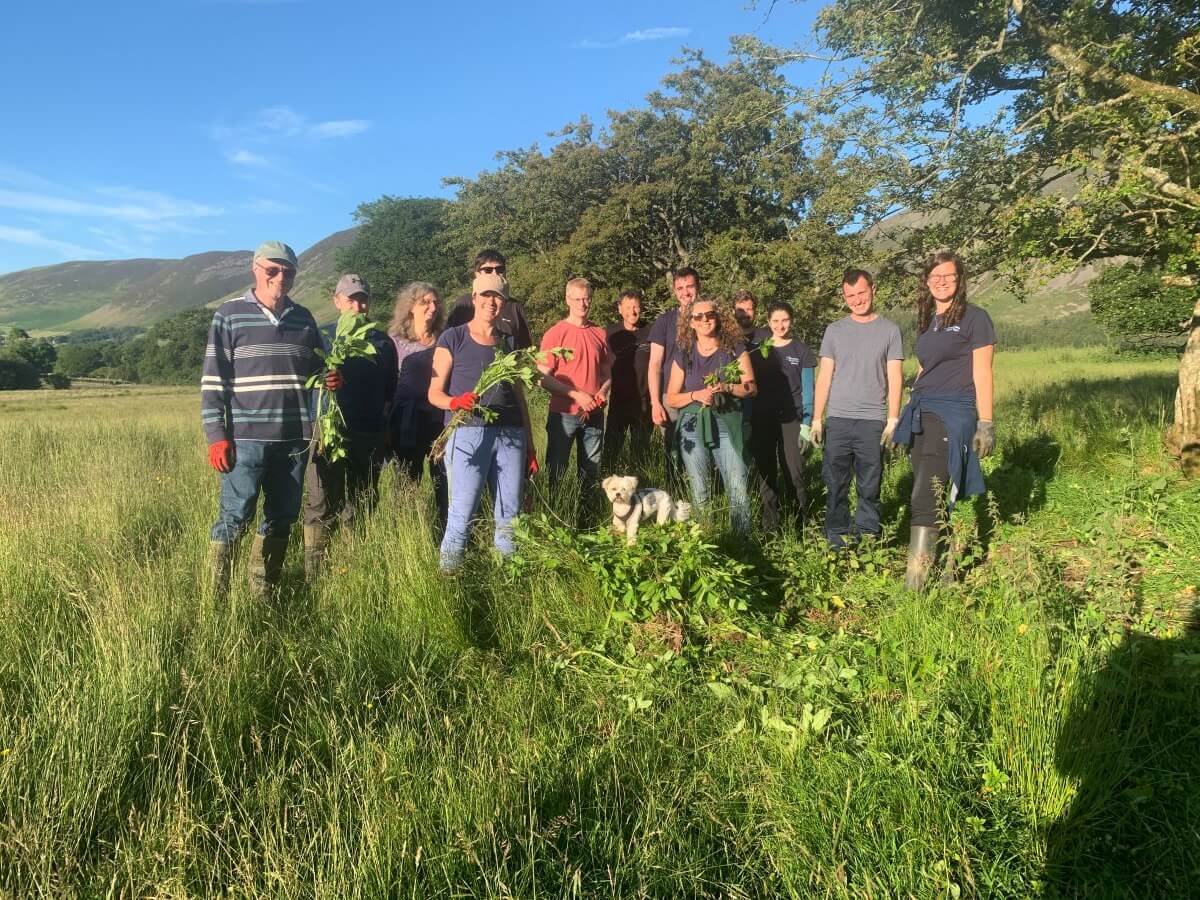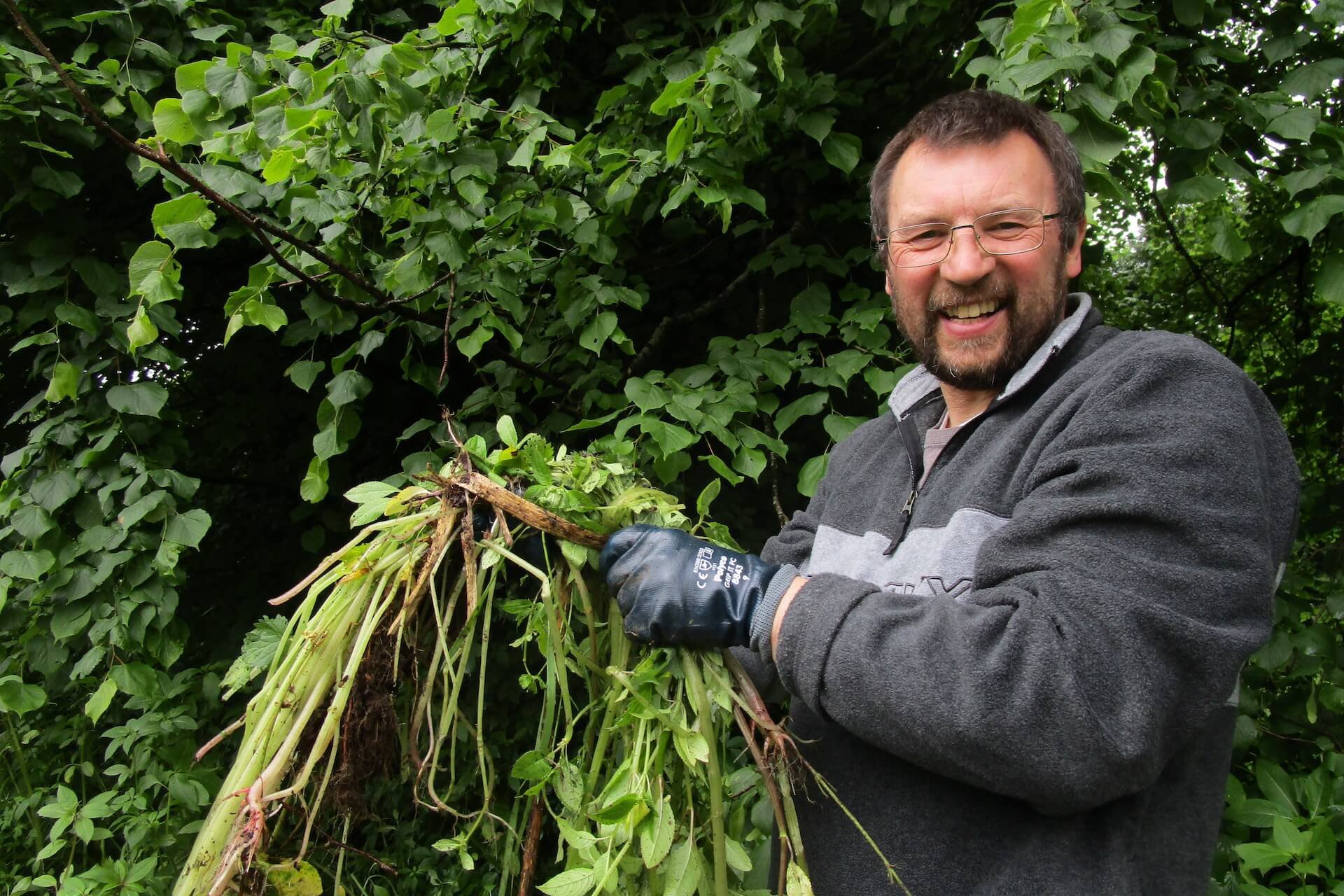
Invasive non-native plants
Whilst our gardens may have been greatly enriched by the introduction of
plants from abroad, a small number have spread so easily and quickly (becoming invasive) that they’ve threatened natural habitats, outcompeted native plants and caused lots of issues for our native plants and wildlife.
Becoming aware of what Invasive Non-Native Species (INNS) are is the first step to tackling the problem. There are many INNS plants in the UK, but we’ve listed the worst offenders tp be found in Cumbria below.
All images courtesy of RPS Group plc unless otherwise stated.
Did you know - it is a criminal offence to plant or cause to grow a non-native invasive species in the wild
Himalayan Balsam
(Impatiens glandulifera)
This plant dominates our waterways outcompeting native plants and reducing biodiversity. It has a very short root structure which means that when it dies back in the winter it leaves bare banks leading to erosion and poor water quality. Its sweet nectar is a favourite for bees (but this doesn’t give pollinators a diverse, healthy diet and has damaging affects on native plants).
Produces 250-2500 seeds
Seeds survive up to 3 yrs in soil
Can grow to 2.5 metres tall
Exploding seeds spread 7 metres
New Zealand Pigmyweed
(Crassula helmsii)
This green stemmed plant is an invasive lake weed with short fleshy leaves that grow in alternate pairs. Viewed from above it looks like lots of tiny stars. It creates dense mats which extend from the surface up to three metres deep that shade out other native species, interrupt the spawning grounds of rare fish like Vendace, and deplete oxygen.
The mats have been known to clog up waterways disrupting swimmers or paddlers, making it near impossible to enter the water.
2cm of weed is all it takes to spread
The spread is almost entirely due to transfer from water sport equipment or clothing
Introduced from Tasmania in 1911
Only the male plant is in the UK
It favours the breeding grounds of rare fish such as Vendace
Purple Pitcher Plant
(Sarracenia purpurea)
Whilst not widespread in the UK, this invasive, carnivorous plant can be found in nutrient poor bogs and is particularly problematic for Sphaghnum moss, which reduces the ability of the peat to form.
It has a cluster of modified, tubular leaves that trap insects, beetles and spiders lured by its bright colours and sweet nectar. The leaves are green, yellow, or reddish with purple veins and hooded open lids. Downward-pointing hairs on the surface of the leaf help ensure that once inside, unsuspecting creatures can’t escape. Its long flower stalks carry a single, nodding, cup-shaped flower that has deep purple petals.
Image: Jason Goh
Each flower can produce 1500 seeds which can survive for 5 yrs
Insects actually drown in the liquid that pools at the bottom of the plant
Introduced from North America
First cultivated in UK in 1640!
Giant Hogweed
(Heracleum mantegazzianum)
Giant Hogweed looks like an enormous cow parsley plant. It’s the most dangerous INNS in our area. The plant’s sap can cause burns once exposed to sunlight.
Early in the season it can be easily mistaken for the much smaller species Common Hogweed.
It forms a rosette of jagged, lobed leaves in the first year before sending up a flower spike in the second year and then setting seed.
Image: Ria
Native to the Caucasus Mountains & Central Asia
It can grow from 1.5 to 5 metres tall with a spread of 2 metres
It can produce 50,000 seeds per seed head
American Skunk Cabbage
(Lysichiton americanus)
Legally sold until 2009, this plant was particularly popular for ponds. It likes to dominate wet woodlands, which are particularly sensitive habitats for lichens and mosses, but you’ll also find it along riverbanks and in peat bogs. It’s large rhizome structure underground means that digging out a mature plant is challenging.
Large waxy leaves can grow up to 1.5 metres long
Seeds survive 7 years in the soil
Similarities with Lords-and-Ladies
Canadian/Nuttall’s Waterweed
(Elodea canadensis | Elodea nuttallii)
These two plant species are so similar that it’s quite difficult to tell them apart. They both grow in whorls of 3-4 leaves, branching stems up to three metres long, and require high levels of Nitrogen and Phosphorus to thrive. They live entirely underwater usually in still or slow flowing waters and are perennials. Like Pigmyweed, they can grow from very small fragments and quickly outcompete native plants, forming a dense monoculture that drives down species diversity. Canadian Waterweed has more oval leaves whilst Nuttall’s are more strap-shaped.
Native to north America
Can be found in lakes, canals and slow moving rivers
The dense growth can impede the flow of slow-moving waterways exacerbating flooding
Montbretia
(Crocosmia)
A favourite with gardeners, this plant quickly escaped and has come to dominate along rivers and streams.
Known for its fiery orange flowers, it is a herb growing 25-50cm tall. It grows in dense colonies, outcompeting native plants and is particularly destabalising for streambanks as the corms (underground storage organ) can become heavy.
Once established, it is very hard to eradicate due to its rhizome root structure.
The seeds are usually not viable - it spreads vegetatively
Native to South Africa
Cotoneaster
(Cotoneaster)
These shrubs and small trees produce huge amounts of red berries (a favourite with birds - which is how it spreads!). They have small, waxy leaves with pink or white flowers
It creates dense thickets which outcompete native species. Their extensive root systems make them difficult to remove.
Small waxy leaves with small pink or white flowers in the spring.
Native to Eastern Asia
Over 100 different species of Cotoneasters are cultivated in the UK (not all are considered invasive)
Causes particular problems in grasslands
Japanese Knotweed
(Reynoutria japonica syn. Fallopia japonica)
This plant produces tall, dense and fast-growing clumps of bamboo-like stems, flecked pink and purple. Leaves are heart-shaped and small, clustered white flowers are produced in the late summer. It produces dense stands that quickly out-compete native species.
Stems can grow up to 2.5m tall
Only one sex of the plant was introduced to the UK
Only spreads vegetatively
Curly Waterweed
(Lagarosiphon major)
Very similar to Canadian and Nuttall’s Waterweed, it grows in still or slow flowing waters and has branched stems up to 3 metres in length with incredibly curly leaves that spiral around the stem.
It grows vigorously from small fragments and quickly outcompetes native plants.
Native to southern Africa
Only the female plant is in the UK
First recorded in the UK in 1944
Rhododendron
(Rhododendron)
A common, evergreen garden plant that has come to dominate our woodlands. It can be a small shrub or great, towering trees up to 8 metres high. They have easily identifiable colourful flowers and waxy, dark green oval leaves.
It forms dense thickets which shade out native plants and prevent the regeneration of trees and vegetation on moors. It produces millions of tiny seeds which are distributed by the wind leading to a large seedbank across a large area. It’s can be very difficult to kill requiring a mix of manual removal, burning and herbicide.
It is a host for a fungal disease which kills Oak and Beech trees.
Introduced in late 18th century
It was first used for game cover and stock shelters
Poisonous to livestock
Cherry Laurel
(Prunus laurocerasus)
Cherry Laurel is an evergreen shrub which grows in dense thickets between 5 and 15 metres tall.
It has shiny, dark green, leathery leaves with a finely serrated margin.
White flowers are produced on upright spikes and followed by dark cherry-like fruits in the autumn.
It grows rapidly and is very tolerant of drought and shade which helps it quickly outcompete native species.
The leaves & seeds in the fruit contain cyanide
Laurel is often used for hedging due to its dense foliage
It comes from South West Asia
Our work tackling INNS and how you can help.
Find out more about our work to tackle Invasive Non-Native Species (INNS) in West Cumbria and get involved.

Become a volunteer
Make new friends, get plenty of exercise in the glorious outdoors and achieve some great results for nature – what’s not to love about volunteering for WCRT!?












